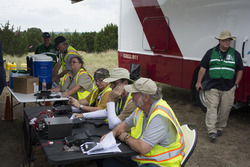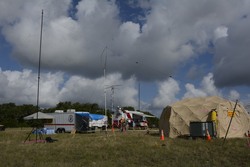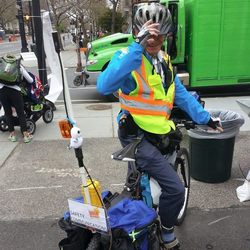 October 19, 2016 Editor: Rick Palm, K1CE | ||||||
This Issue:
Editor's Notes from Hurricane Matthew Earlier this month, major category five (on the Saffir-Simpson hurricane wind scale) Hurricane Matthew destroyed lives (more than 1,000 perished) and property on its wicked path through the Caribbean and on up the southeast coast of the US, to the Canadian Maritimes. The responses of many ARES® and partner entities are documented in the ARRL news stories linked below; many after action reports noting lessons learned are expected in the weeks to come. Northern Florida coastline was heavily impacted by Matthew; the eye wall brushed Daytona Beach, where I live, at around 1 PM Friday, October 7, with wind and gusts that toppled large trees, and ripped off shingles and roofs. The storm eroded beaches and took out coastal roads such as historic route A1A in Flagler county, just to the north of Daytona Beach here in Volusia county. I rode out the storm at home just three miles from the beach, which is not recommended, but I had an obligation to work at the city hospital for the vulnerable patient population, so I could not evacuate. On battery power, I checked into the Volusia County ARES net on the 147.24 MHz KV4EOC repeater located at the large county EOC west of Daytona. Remarkably, the repeater never lost viability, and net control stations, although weary,
performed flawlessly for the duration, taking and relaying reports of damage, and logistical requests. For example, issues with staffing and protocol at area Red Cross special needs shelters were handled and resolved over the repeater. The Daytona Beach city EOC, located at the city's police headquarters, was checked into the net by its station N4DAB, with operator ARRL Northern Florida Section Manager Steve Szabo, WB4OMM, at the helm. Szabo, a retired law enforcement officer, pulled 67 hours of duty there over the course of four days. He was able to monitor HF and VHF storm-related communications, and said "What I heard was capable, professional net control operation and excellent cooperation by the amateur community at large in keeping those frequencies clear for safety of life communications." I suspect that this operator scenario was repeated hundreds of times throughout the storm impacted areas. -- K1CE [Please copy and send your after action reports and lessons learned to [email protected] for follow-up discussion in this newsletter. Thank you. -- ed.] ARES Briefs, Links Hurricane Watch Net Active as Hurricane Nicole Passes Over Bermuda (10/13/16); Hurricane Watch Net to Reactivate for Hurricane Nicole (10/12/16); Amateur Radio Response Continues as Hurricane Matthew Moves Up East Coast (10/8/16); Hurricane Watch Net Stands Down Following Record Activation for Hurricane Matthew 10/9/16); ARES Activates as Florida Girds for Hurricane Matthew (10/6/16); Frequencies in Use in Conjunction with Hurricane Matthew Response (10/5/16); Florida Coastal ARES Groups at Local Activation Level, Statewide Declaration Pending (10/5/16); Hurricane Watch Net Ramps Up to "Catastrophic Response Mode" for Matthew (10/4/16); ARRL Invites Nominations for 2016 International Humanitarian Award (10/4/16); Radio Amateurs in Cuba Stand Ready for Hurricane Matthew (10/3/16); Hurricane Watch Net Now Active as Hurricane Matthew Targets Jamaica, Haiti, Eastern Cuba (10/2/16); Amateur Radio Credited with Helping Injured Cyclist (9/28/16); Amateur Radio Volunteers on Call during Major Puerto Rico Power Outage (9/23/16) "Overview of Army and Air Force MARS" Webinar Set for October 25 Registration is open for the webinar "Overview of Army and Air Force MARS," October 25 at 8 PM ET (0000 UTC on October 26). US Air Force MARS Chief Dave Stapchuk, KD9DXM, will discuss the history of the Military Auxiliary Radio System (MARS) program and membership requirements for Amateur Radio operators. He also will highlight the Joint MARS Phone Patch network, which provides daily support to US armed forces. The phone patch network facilitates not only morale/welfare phone patches but routinely handles mission-related radio calls and occasionally assists US air crews with in-flight emergency phone patches when air traffic control cannot be reached. US Army MARS Program Manager Paul English, WD8DBY, will discuss the quarterly US Department of Defense (DOD) contingency communication exercises, which promote interoperability between the Amateur Radio community and the DOD. English will also discuss initiatives for promoting the use of 60 meters between Amateur Radio and the federal government as well as the types of information MARS operators will request from the Amateur Radio community during the upcoming quarterly DOD communications exercise (COMEX), October 30-November 1. Webinar registrants will receive a confirming e-mail that contains information about joining the webinar. Get Your Radio On: SKYWARN Recognition Day, December 3 The annual SKYWARN ⢠Recognition Day (SRD) will be held this year on Saturday, December 3, 2016. This is the day when Amateur Radio operators visit National Weather Service (NWS) offices and contact other operators around the world. The purpose of the event is to recognize the vital public service contributions that Amateur Radio operators make during National Weather Service severe weather warning operations. It also strengthens the bond between Amateur Radio operators and the local National Weather Service. The event is co-sponsored by ARRL and the National Weather Service. Please remember that this is not a contest, so no scoring will be computed. Object: For all radio amateur stations to exchange QSO information with as many National Weather Service stations as possible on 80 through 10 meters, including 6 and 2 meters bands and the 70 centimeter band. Contacts via repeaters are permitted. Date: National Weather Service stations will operate December 3, 2016, from 0000 - 2400 UTC. Exchange: Call sign, signal report, QTH, and a one or two-word description of the weather occurring at your site. Modes: National Weather Service stations will work various modes including SSB, FM, AM, RTTY, CW and PSK31. While working digital modes, special event stations will append "NWS" to their call sign (e.g. NØA/NWS). Station Control Operator: It is suggested that during SRD operations, a non-National Weather Service volunteer who is a licensed radio amateur serve as a control operator for the station that is set up at a NWS office. New this year: There will be a new log submission process introduced this year, and W1AW at ARRL Headquarters is scheduled to be on the air for SKYWARN Recognition Day. More details will be released later. More information about this event may be found here. IARU Region 2 Emergency Communications Workshop Held in Chile; New Technologies for Emergency and Disaster Response Discussed The second IARU Region 2 Emergency Communications Workshop was held October 11, 2016 in Viña del Mar, Chile in conjunction with the IARU Region 2 XIX General Assembly. Sponsored by IARU Region 2 and the ARRL, the workshop was chaired by Mike Corey, KI1U, ARRL Emergency Preparedness Manager and IARU Area B EC. Co-chair was Dr. Cesar Pio Santos, HR2P, IARU Region 2 EC. Topics covered the use of Winlink, SATERN support for Salvation Army disaster response, the role of ITU, developing operator and communications skills, AREDN mesh networking technology for disaster response, and emergency communications response in Venezuela. Goals included sharing information on Amateur Radio response to emergencies in the region, and : ⢠Increasing the capacity for Amateurs in Region 2 to respond to large scale, multinational communication emergencies. ⢠Provide an opportunity for national level Amateur Radio emergency communications leaders to network and increase the level of cooperation and collaboration within the IARU Region 2. ⢠Build upon topics and discussions from the previous emergency communications workshop and about specific events that transpired since the first workshop. For more information and photos from the workshop, please see the IARU Region 2 website. Dual Exercises in Missouri: ARRL Field Day 2016/Infrastructure Support Exercise The morning of June 25, 2016, presented a sweltering 86 degrees and rising, with humidity over 50%. This year, Field Day was a combined exercise of the St. Charles County (Missouri) ARES®, sponsored by the Emergency Communications Association of St. Charles County (ECA), and the county's Division of Emergency Management (DEM) under the county police department. ECA/ARES® and the DEM have enjoyed a long, cooperative relationship for many years. In January, a new communications trailer project was rolled out, with the finished product tested extensively in June's dual exercises. The trailer, provided by the county Police, was repainted, adorned with decals, and improved with air conditioning, radio benches, and windows. The trailer has five operating positions: Two positions are fitted with amateur VHF/UHF FM equipment (Yaesu FT-8900 transceivers), with packet Other communication assets carried onboard include a grab and go kit containing HF and VHF/UHF transceivers with accessories and a second grab and go kit for 2-meters - an Icom IC-2200 and six IC-V80 Sport handhelds. Four roof-mounted antennas, an HF antenna for NVIS, VHF/UHF dual band base antennas, and two push-up poles comprised the antenna complement. ECA/ARES® members installed
the electrical system, computer network, roof antennas, radios, the front mounted push-up pole and other assets to make the trailer a working mobile communications platform to be shared by ECA, DEM, and the county Police. A week before Field Day, the emergency management division purchased a tower trailer, which was equipped with a 60 foot square telescoping tower, a 10 kilowatt diesel generator and an equipment cabinet. The main purpose of the exercise, held in conjunction with Field Day, was to field test the new trailer, tower trailer and new equipment in a potential real-world infrastructure support role where communications is impacted by natural and man-made disasters. ECA/ARES® operators worked most of the states, provinces in Canada, Hawaii and Puerto Rico over the Field Day weekend, demonstrating the potential use of HF radio in national infrastructure support. Three antennas were demonstrated in the 2A category-configured stations. A tri-band beam was mounted atop the 60 foot tower and a dual band (40/80 meters) wire dipole was suspended from a stand-off at the top of the tower. A multi-band NVIS antenna was also deployed and demonstrated. Instruction was provided by the Division of Emergency Management on the deployment and use of the tower trailer. The County Police Department granted use of its media room at the department headquarters to run the second station. The 10 KW generator powered the communications trailer station; the second station was battery powered with generator backup. The team of seasoned operators did a fine job of collecting QSOs to demonstrate capabilities. The relationship between the Division of Emergency Management and ECA/ARES® in St. Charles County Missouri has been mutually beneficial and cooperative. Just a few weeks prior to Field Day some St. Charles County ARES members were asked to participate in a tabletop exercise in the St. Louis County EOC for the purpose of establishing parameters for the design of the new St. Charles County According to Bill Grimsbo, NOPNP, District C District Emergency Coordinator and St. Charles County EC, "In my 20 plus years with ARES®, I have never seen cooperation in any other county or city that compares with the levels of St. Charles county. The St. Charles County Division of Emergency Management and the County Police Department are true partners with ECA and ARES® in response and preparedness to a degree I've never experienced." This relationship is set with a Memorandum of Understanding that became an ordinance between ECA and St. Charles County DEM signed in 1998. ECA/ARES® responds regularly to activations for severe weather, which is a regular occurrence in the St. Louis metropolitan area and outlying counties. Flooding has also been a frequent event over the past several years. "The cooperative efforts of St. Charles County ARES®, ECA and the DEM under the County Police has made our county a safer and more secure place to live and we intend to continue these efforts into the future," said Grimsbo. "Field Day is a wonderful opportunity to demonstrate to the residents of our community what tools are being brought to bear by Amateur Radio operators as well as response professionals when we work together as a cohesive response asset in our county." -- William Grimsbo, NOPNP, Missouri District C District Emergency Coordinator and St. Charles County Emergency Coordinator; and Jeff Young, KB3HF, Saint Peters, Missouri Texas Hams Drill with Public Safety in Major Exercise Williamson County (Texas) ARES members were integrated with the county's Emergency Communications, Office of Emergency Management, Sheriff's Office, and other partners for a planned full-scale exercise dubbed Basic Assessment of Interoperability of Telecommunications (BAIT), held June 24 and 25, just prior to ARRL Field Day 2016 at the county park in Liberty Hill, Texas. All county emergency communications mobile assets were deployed to the park to simulate a complete failure of public safety communications infrastructure. Objectives included remotely dispatching public safety units within the county and integrating Amateur Radio communications into the process. The team of county telecommunications employees and Amateur Radio operators, under the direction of Incident Commander Lt. Aubury Holmes, KG5FTD, began setting up base camp two days ahead of the exercise. ARES members erected four portable Blue Sky masts and installed antennas covering HF bands. They set up an amateur HF station in the county's Regional Mobile Communications (RMC) truck. Williamson County Communications Director Scott Parker, KE5OJC, established goals for the exercise, including having the Resource Unit maintain full accountability of resources and personnel on site, to monitor public safety resources remotely, and to dispatch fire, EMS and law enforcement from the remote site. In addition to radio and antenna deployment, ARES members were tasked with setting up and operating a generator trailer and HF go-kits with PACTOR 3 capability to full functionality. Another goal was to deploy APRS systems to track assets on the park property in real time, creating "breadcrumb" trails showing where units had been. Part of the park lies in a river valley beneath a bluff that could inhibit radio transmission from the canyon, so ARES members set up a crossband repeater on the rim of the canyon and an APRS digipeater, enabling the Incident Management Team (IMT) to reliably track search and rescue (SAR) assets and communicate with them from the Command Post. Fire Departments conducted the SAR maneuvers -- each team was outfitted with an APRS tracking device so leaders could monitor the progress of the search. The digipeater successfully relayed tracker information to the Command Post. Twenty-nine Williamson County ARES (WC-ARES) members filled many of the Incident Command System Command and General Staff positions on the IMT. Seasoned IMT members provided guidance upon request, but ARES personnel functioned at a high level. WC-ARES Emergency Coordinator Terry Jones, K5LGV, served as Operations Section Chief, and John Peek, KF5ZMD, served as Planning Section Chief. Other ARES operators exercised skills they would need if they were ever called upon to fill dispatch positions in the public safety environment, as well as all the technical skills required for a remote communications operation. Communications vehicles outfitted with amateur HF radios were sent out to surrounding counties with ARES members operating the radios. They tested coverage without using repeaters to confirm the ability to get traffic from a 100-mile radius. Band conditions were less than optimal and yet successful contacts were completed after mobile antenna configurations were modified. Planning began two months prior to the event, with weekly meetings involving all key players. Once players were identified and assigned, work began on producing an event action plan. An exercise of this magnitude involves a host of logistics to get equipment in place and provide for necessary services needed by personnel. Planners
knew that environmental conditions would be extreme with temperatures near 100 degrees, so keeping personnel hydrated was a concern. Meeting nutritional needs of such a large staff was challenging. The Salvation Army brought their canteen truck to the site and provided lunch for the participants. Williamson County Communications had already provided a trailer for ARES use, outfitted with dual band radios, HF capability, and 800 MHz trunking public safety radios. WC-ARES personnel remodeled the trailer, turning it into a two-room communications center. This platform provided a second air-conditioned operating position. The Capital Area Trauma Regional Advisory Council (CATRAC) participated by providing an RV trailer for the check-in point and a box trailer with a 45 KW generator that became a 2-meter packet and HF PACTOR operating position. CATRAC also provided and set up an air-conditioned DRASH tent for the command team that was used for the GOTA station during Field Day activity. The Travis County Radio Emergency Associated Communications Team (REACT) provided their 3DRobotics Solo quad copter for aerial surveys and for search and rescue. On Saturday, June 25, the operation transitioned to Field Day activities, all taking place in the air conditioned comfort of the equipment set up for the exercise! A Williamson County Commissioner, county parks director, and county Public Information Officers visited the base camp and observed the exercise in operation.
At one point on Saturday, there were 74 people on site including visitors and participants. ARRL South Texas Section Manager Lee Cooper, W5LHC, visited the site and observed the exercise. Local television station KXAN came to base camp for a story on the exercise. Local newspapers also provided coverage. This full-scale ICS exercise required a daily Event Action Plan, and provided exposure to and practice with essential ICS forms. It provided an opportunity to familiarize ARES members with the ICS processes involved in any Type I or Type II incident. At the end of Field Day all equipment was taken down, packed and returned to service. Each team member went through the demobilization process as if they were on a major incident. This exercise gave ARES members a chance to meet or deepen relationships with various officials from around the county, and to share our passion for radio with them. "I didn't expect APRS to be a big part of Field Day," said WC-ARES Board Member Jonathan Estill, AF5DF, "but I became an expert in configuring several trackers used during the exercise. Williamson County purchased several different APRS radios, ranging from Byonics and SainSmart trackers, and Kenwood TH-D72A and TM-D710GA radios for tracking assets like SAR teams in emergencies. The trackers provided near real-time position updates about teams deployed beyond the base camp." Lessons Learned
Williamson County ARES is extremely grateful to Williamson County Emergency Communications for giving our members the opportunity to participate and learn from such a complex exercise. -- Ken Malgren, K7MAL, Emergency Communications, Williamson County, Texas Letters: On CERT Austin, Texas -- In our Community Emergency Response Team (CERT) training classes (2 or 3 times a year) I make a short presentation about communications, how it is necessary with some understanding of the need and how to be of service with Amateur Radio support. At the conclusion of the session, the students can sign up for licensing classes. We now have several amateurs in the CERT ranks. In a recent CERT meeting, a show of hands indicated about 50% of those in attendance were licensed and members of local clubs and ARES. Our CERT classes are normally hosted in the city/county EOC where the amateur station is also housed. I have been involved with the City of Austin CERT from its inception, and help with administration, leadership, and teaching. Other response organizations share needs and should have the same opportunities for learning and participating to be communications prepared. To help in this direction, we are building a cooperative Council of organizations in our ARRL South Texas District 7 (8 counties) to be able to adequately communicate and be stronger together in any situation. The Council will operate much like Volunteer Organizations Active in Disaster (VOAD), with the purpose of bringing all organizations to the table regularly to discuss, train, plan, and to be able to work together in time of need. All volunteer groups are invited to be involved and representatives are encouraged to attend the monthly meeting, conducted by teleconferencing. Each organization is encouraged to bring ideas for training and exercises to the table and reports of response activity. Amateurs involved in the participating organizations are encouraged to give and take emergency and disaster response communications training. -- Roger Wines, W5WIA, ARRL South Texas Section Assistant DEC (District 7) Dress for Public Service Success Visiting this year's ARRL New England Convention in Boxboro, Massachusetts, I was delightfully surprised at the level of care most attendees, and in particular exhibitors, speakers and volunteers, exercised in their choice of attire. Snazzy uniform shirts worn by vendors were in abundance. Business attire infused the exhibit hall. It was as if I were attending a professional conference. There I met new ARRL CEO, Tom Gallagher, NY2RF, whose sharp business attire transmitted an easy-on-the-eyes message, one that clearly respected the first impressions of his constituents. Among the subjects discussed was my contention that our community must take better care to present ourselves as organized professionals when serving in a public service role, most especially in how we look. As a leader of public service teams, and an advocate for better leadership, innovation and national unity in our public service communications role, I make sure every volunteer has the opportunity and support that encourages their personal success. Not only are my teams well trained and fully integrated into the organization or agency we serve, they also look (and smell) good. That's because expectations for attire are part of the pre-event preparations. I urge volunteers at some events to be "smartly dressed with a clean white shirt and blue uniform pants, or equivalent." A volunteer T-shirt is sometimes needed as an added bit of identification and to unify us as members of a larger team, so I request that we "wear the supplied volunteer T-shirt in combination with uniform or EMT cargo pants to present a professional appearance." I also caution that we must not be confused with public safety or law enforcement personnel. "Professional" does not mean that we have license to impersonate, however innocent our first intention! I have first-hand experience to suggest that those who present themselves professionally are invited back for the next event service opportunity. While some of us grumble about how disorganized the organization we're serving may be -- how little they understand about the value of our "superior" communications service -- we are ultimately
responsible for an invitation back to a repeat performance. So what happens when we're not? Some of us lean upon that tired "when all else fails" excuse: "When all else fails you'll call upon us, and you won't care how we look." Weak. Irrelevant. Arrogant. Please throw those rags in the laundry (or incinerator) and come back civilized. This is not a mud wrestling match. At each public service event I've had the privilege and fun to work as a communications volunteer, the event organizers, public safety, vendors, and participants arrive dressed for the occasion. We are not exempt. If your leadership fails to set a minimum standard, that doesn't mean you can't arrive on time and ready to go with a professional, smart, confidence-inspiring appearance. You'll look good, feel great, and be amazed how receptive your team mates, the organizers, participants and the public will be when you dress for public service success. -- Mark Richards, K1MGY, Littleton, Massachusetts [Richards is a member of the Boston Athletic Association's Boston Marathon Communications Committee, with an extensive history of leadership in numerous public event communications efforts. Richards is a frequent contributor to the ARRL ARES E-Letter. -- ed.] Tips: Net Protocols for Practice Like many groups, the Hospital Disaster Support Communications System (HDSCS) holds a weekly net, but the HDSCS net focuses on practicing procedures related to functioning in a real net during an emergency. While we practice taking turns at being net control, members also must copy down check-ins and information given on the net. Sometimes net participants are asked to move to other frequencies identified by tactical reference. This week, after check-ins were taken, members were asked to move to simplex on the output of our primary net repeater. Then the check-ins were roll called. Not only was this little task a way to make sure members could make the adjustments on their equipment to respond on the output, but it also allowed members to serve as relays when necessary. Should our primary repeater go down in a major emergency, we would maintain a presence on the output of our repeater to listen for, not only our members, but for other groups that might need to contact us. Most members made it to the output of the repeater quickly and then learned what they could hear. Two stations were particularly valuable in their ability to hear stations in the Laguna Niguel area as well as the southeast part of Orange County. All check-ins were accounted for in the roll call by the net control, with some help from stations that were able to relay for others. It was an instructive exercise that will get repeated again. -- from the Hospital Disaster Support Communications System report for October 16, 2016; April Moell, WA6OPS, HDSCS, Orange County, California Third Annual Joint Tribal Emergency Management Conference held in ARRL San Joaquin Valley Section For the third year in a row, ARES/RACES was a featured part of the largest gathering of tribal disaster preparedness, recovery, hazard mitigation, and homeland security professionals in the country. This annual conference is organized by the National Tribal Emergency Management Council, and was hosted on September 19-23, 2016, by the Tachi-Yokut Tribe at their Santa Rosa Rancheria in Lemoore, California. ________ ARRL -- Your One-Stop Resource for Amateur Radio News and Information Join or Renew Today! ARRL membership includes QST, Amateur Radio's most popular and informative journal, delivered to your mailbox each month. Subscribe to NCJ -- the National Contest Journal. Published bi-monthly, features articles by top contesters, letters, hints, statistics, scores, NA Sprint and QSO Parties. Subscribe to QEX -- A Forum for Communications Experimenters. Published bi-monthly, features technical articles, construction projects, columns and other items of interest to radio amateurs and communications professionals. Free of charge to ARRL members: Subscribe to the ARES E-Letter(monthly public service and emergency communications news), theARRL Contest Update (bi-weekly contest newsletter), Division and Section news alerts -- and much more! Find us on Facebook. Follow us on Twitter. ARRL offers a wide array of products to enhance your enjoyment of Amateur Radio Donate to the fund of your choice -- support programs not funded by member dues! Click here to advertise in this newsletter, space subject to availability. | ||||||

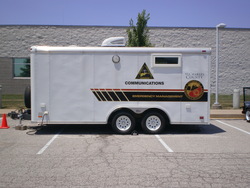 radio capability at one position. The third position is fitted with amateur HF with an Icom IC-706 transceiver. Positions four and five are reserved for public safety systems (Motorola XTL 2500 VHF and 800 MHz trunking radios). A computer network is installed with peripherals. A 6500 watt generator powers the systems, along with a 12 V battery backup system.
radio capability at one position. The third position is fitted with amateur HF with an Icom IC-706 transceiver. Positions four and five are reserved for public safety systems (Motorola XTL 2500 VHF and 800 MHz trunking radios). A computer network is installed with peripherals. A 6500 watt generator powers the systems, along with a 12 V battery backup system.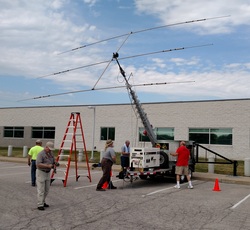
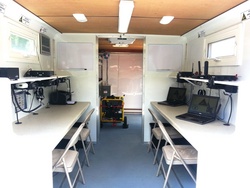 EOC. The scenario was an F3 tornado touching down in Weldon Spring, Missouri, cutting a path of destruction through eastern St. Charles County. This was a familiar scenario to some who responded to the real thing just two years before. ECA/ARES® served as the sim cell in this exercise and provided recommendations for the new EOC.
EOC. The scenario was an F3 tornado touching down in Weldon Spring, Missouri, cutting a path of destruction through eastern St. Charles County. This was a familiar scenario to some who responded to the real thing just two years before. ECA/ARES® served as the sim cell in this exercise and provided recommendations for the new EOC.